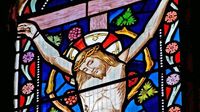For Christians around the world, Easter represents the pinnacle of their faith, commemorating the death and resurrection of Jesus Christ. This year, the observance of Easter will take place later than usual, with Good Friday falling on April 18 and Easter Sunday on April 20, 2025. The significance of these dates and the traditions surrounding them are deeply rooted in the events of the Holy Week, which begins with Palm Sunday, marking Jesus' triumphant entry into Jerusalem.
The Holy Week consists of several important days: Palm Sunday, Maundy Thursday, Good Friday, Holy Saturday, and Easter Sunday. Each day holds a special significance in the Christian calendar, culminating in the celebration of the resurrection of Christ on Easter Sunday. The term "Holy Week" derives from the Old High German word "kara," meaning sorrow or mourning, reflecting the somber events leading up to Easter.
On Palm Sunday, Christians remember Jesus' entry into Jerusalem on a donkey, greeted by crowds who laid down their cloaks and palm branches, symbolizing their recognition of him as the Messiah. This event marks the beginning of the Holy Week, a time of reflection and preparation for the significant events that follow.
Maundy Thursday commemorates the Last Supper, where Jesus shared a final meal with his twelve disciples. It is during this meal that Jesus instituted the Eucharist, a sacrament celebrated in many Christian denominations today. According to tradition, this is also the day when Jesus washed the feet of his disciples, demonstrating his humility and service. Later that evening, he was betrayed by Judas Iscariot, who sold him for thirty pieces of silver, leading to his arrest.
Good Friday, the day of Jesus' crucifixion, is a day of mourning for Christians. It is observed with solemnity, as believers remember the suffering and death of Jesus on the cross. In many Catholic churches, the altar is stripped bare, the bells remain silent, and the tabernacle is left empty, symbolizing the grief of the day. Many congregations hold services at 3 PM, the hour traditionally recognized as the time of Jesus' death. This day is also a fast day, where Christians are encouraged to abstain from meat and partake in only one substantial meal.
Following Good Friday, Holy Saturday is a day of waiting, as Christians reflect on the time Jesus spent in the tomb. This day leads into the Easter Vigil, which takes place on Saturday evening or in the early hours of Easter Sunday. During this service, the Easter fire is lit, symbolizing the light of Christ coming into the world. The new Easter candle is lit from this fire, and its light is shared throughout the church, representing the resurrection and the hope it brings.
Easter Sunday is the culmination of the Holy Week and the most significant day in the Christian calendar. It celebrates the resurrection of Jesus from the dead, affirming the belief in life after death. According to the Gospel of Matthew, early on the morning of the first day of the week, Mary Magdalene and other women went to Jesus' tomb, only to find it empty. An angel appeared to them, announcing, "He is not here; he has risen!" This proclamation of resurrection is central to Christian faith and is celebrated with joy and festivity.
On Easter Monday, the story continues with Jesus appearing to two of his disciples on the road to Emmaus, as recounted in the Gospel of Luke. These disciples had been disheartened by the events of the previous days, but their encounter with the risen Christ rekindled their faith and joy. They returned to Jerusalem to share the good news of the resurrection with the other disciples.
Interestingly, the dates of Easter vary each year, as the Church established that it should be celebrated on the first Sunday after the first full moon following the vernal equinox. This means Easter can fall anywhere between March 22 and April 25. The year 2025 sees a later celebration of Easter, a timing that may affect various traditions and family gatherings.
In addition to its religious significance, Easter has also become associated with various cultural traditions, such as the Easter Bunny, which, although not a Christian symbol, has become a popular figure in Easter celebrations. The origins of the Easter Bunny can be traced back to pagan traditions, but it has now become a part of the broader Easter festivities, particularly in Western cultures.
As Christians around the world prepare for Easter, they are reminded of the profound significance of these days. The rituals and celebrations serve not only as a remembrance of Jesus' sacrifice but also as a source of hope and renewal. The resurrection is a celebration of life, symbolizing the victory of good over evil, and the promise of eternal life for all who believe.
As the Easter season unfolds, communities will gather for services, family meals, and various traditions that reflect both the solemnity and joy of this sacred time. Whether through attending church services, participating in Easter egg hunts, or sharing meals with loved ones, the essence of Easter remains a powerful reminder of faith, hope, and the enduring message of love.
In the end, the observance of Easter is not just about the events that transpired over two millennia ago; it is about the impact those events have on the lives of believers today. As they reflect on the meaning of the resurrection, Christians are called to live out the principles of love, forgiveness, and compassion that Jesus exemplified in his life.







